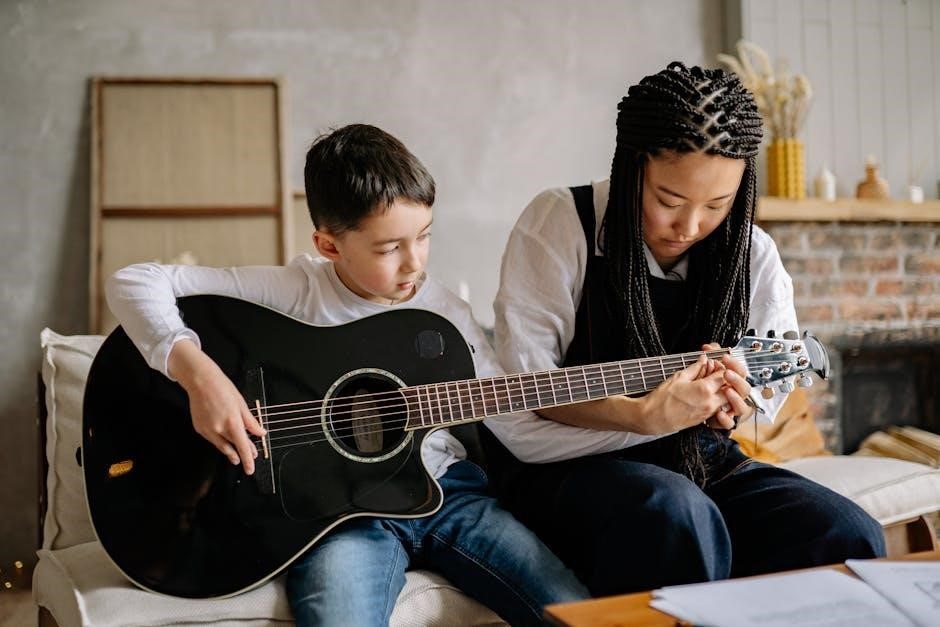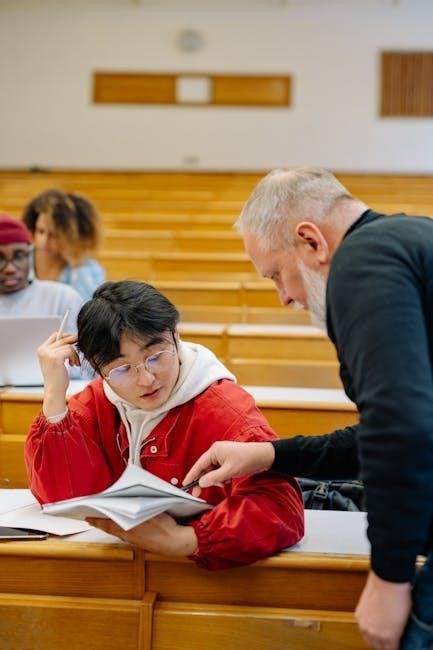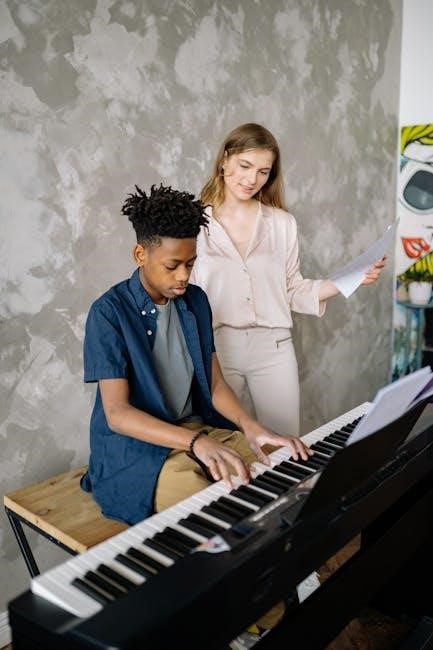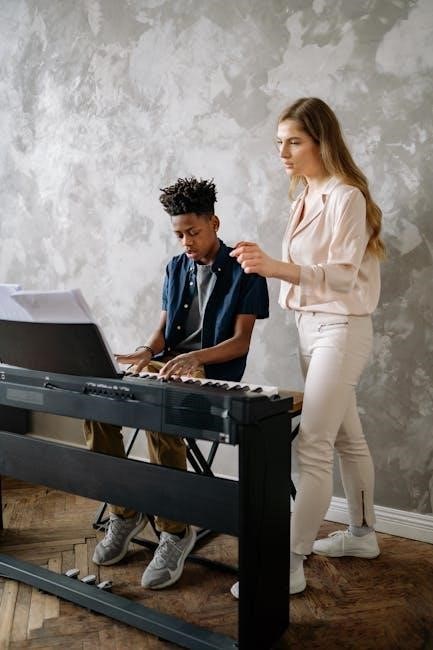Teaching and coaching share a common foundation in instruction, both aimed at fostering growth, enhancing skills, and promoting meaningful learning experiences for personal and professional development.
Overview of Teaching and Coaching
Teaching and coaching are both instructional practices aimed at fostering growth and development. Teaching typically occurs in educational settings, focusing on imparting knowledge and intellectual skills. Coaching, often found in sports or professional contexts, emphasizes skill mastery and performance improvement. Both roles require a deep understanding of the learner’s needs, using tailored strategies to enhance capabilities. While teaching centers on curriculum delivery, coaching prioritizes personalized guidance. Both share the goal of empowering individuals to reach their full potential through structured instruction and supportive feedback, blending art and science to create meaningful learning experiences.
The Importance of Instruction in Both Fields
Instruction is the cornerstone of both teaching and coaching, enabling the transfer of knowledge, skills, and values. It bridges gaps in understanding, fosters critical thinking, and supports personal and professional growth. Effective instruction adapts to the needs of learners, whether in a classroom or a coaching setting, ensuring engagement and progress. By providing structured guidance, feedback, and support, instruction empowers individuals to achieve their goals and reach their full potential, making it indispensable in both fields for driving meaningful outcomes and continuous improvement.

Defining Teaching and Coaching
Teaching focuses on imparting knowledge and skills in a structured environment, while coaching emphasizes personalized guidance and skill development to achieve specific goals and improve performance.
Teaching: Methods and Objectives
Teaching involves structured methods like lectures, group activities, and adaptive strategies to meet diverse learning needs. Objectives include imparting knowledge, fostering critical thinking, and developing problem-solving skills. Teachers use various approaches to engage students, ensuring content mastery and personal growth. The goal is to create an inclusive environment where students can achieve academic success and build lifelong learning skills. Effective teaching methods are tailored to student needs, promoting active participation and deeper understanding of subject matter.
Coaching: Approaches and Goals
Coaching employs personalized techniques to enhance skills and achieve specific objectives. Coaches focus on fostering individual growth through targeted guidance and feedback. Their approaches often include setting clear goals, identifying strengths, and addressing areas for improvement. The primary aim is to empower individuals to reach their full potential, whether in sports, professional development, or personal life. Coaching emphasizes continuous improvement, encouraging learners to take ownership of their progress and develop resilience. Effective coaching strategies create a supportive environment for meaningful development and long-term success.

Instructional Strategies in Teaching
Instructional strategies in teaching involve adaptive methods, student-centered approaches, and technology integration to foster critical thinking and inclusivity, ensuring personalized learning experiences for diverse student needs.
Adaptive Teaching Methods
Adaptive teaching methods involve adjusting instruction to meet individual student needs in real-time, fostering critical thinking and inclusivity. These dynamic approaches allow educators to modify strategies based on student responses, ensuring personalized learning experiences. By incorporating diverse techniques and resources, adaptive teaching enhances engagement and understanding. It aligns with educational goals, promoting equity and encouraging students to take ownership of their learning. This approach is particularly effective in addressing varied learning styles and abilities, creating a supportive environment where all students can thrive academically and socially.
Student-Centered Instruction
Student-centered instruction prioritizes learners’ needs, interests, and abilities, fostering engagement and empowerment. This approach encourages active participation, critical thinking, and self-directed learning. Educators act as facilitators, guiding students to explore concepts and solve problems independently. Personalized learning experiences are tailored to individual preferences and developmental levels, promoting deeper understanding and creativity. By shifting the focus from teacher-led lectures to student-driven activities, this method enhances motivation, collaboration, and overall academic success. It also integrates technology and diverse resources to create inclusive and dynamic learning environments, ensuring all students can thrive and reach their full potential effectively.
Use of Technology in Teaching
Technology has revolutionized teaching by providing innovative tools to enhance instruction and engagement. Educators leverage online platforms, educational apps, and interactive simulations to deliver dynamic lessons tailored to diverse learning needs. These tools facilitate personalized learning experiences, enabling students to explore concepts at their own pace. Additionally, technology promotes collaboration through virtual classrooms and real-time feedback mechanisms, fostering a more inclusive and effective learning environment. By integrating technology, teachers can address individual student requirements, making education more accessible and engaging for all learners, regardless of their background or abilities, thus enhancing overall educational outcomes significantly.

Instructional Strategies in Coaching
Coaching employs tailored approaches to skill development, fostering improvement through personalized techniques and continuous feedback, ensuring learners achieve their full potential in a supportive environment.
Skill Development Through Coaching
Coaching plays a pivotal role in skill development by breaking down complex tasks into manageable components. Coaches provide targeted exercises, real-time feedback, and personalized strategies to enhance proficiency. This structured approach ensures learners progress systematically, mastering foundational skills before advancing to more complex challenges. By focusing on specific areas of improvement, coaching fosters a culture of continuous growth, enabling individuals to achieve their full potential in a supportive and goal-oriented environment.
Personalized Coaching Techniques
Personalized coaching techniques involve tailoring instruction to meet individual needs, ensuring each learner receives targeted support. Coaches use assessments to identify strengths, weaknesses, and learning styles, adapting strategies accordingly. By focusing on specific goals and preferences, coaches create customized plans that maximize progress. This approach fosters a deeper understanding and engagement, as learners feel valued and empowered. Personalized coaching also incorporates real-time feedback, enabling immediate adjustments and fostering a dynamic learning environment that prioritizes individual growth and success.
Feedback Mechanisms in Coaching
Feedback mechanisms in coaching are essential for continuous improvement and growth. Coaches use techniques like observation, reflection, and real-time feedback to guide learners. Regular check-ins and data-driven insights help track progress and identify areas for development. By fostering trust and open communication, coaches ensure feedback is constructive and actionable. This iterative process enables learners to refine skills, address weaknesses, and build resilience. Effective feedback mechanisms in coaching create a supportive environment where learners can achieve their full potential and stay aligned with their goals.

Similarities Between Teaching and Coaching
Both teaching and coaching focus on learning and development, utilizing assessment, communication, and tailored strategies to guide individuals toward achieving their goals and maximizing potential effectively.
Focus on Learning and Development
Both teaching and coaching prioritize learning and development, aiming to enhance skills, knowledge, and personal growth. They utilize assessments and feedback to guide improvement, ensuring tailored strategies meet individual needs. Adaptive approaches in teaching and personalized coaching techniques foster a supportive environment, promoting engagement and progress. By focusing on the learner’s journey, both fields create opportunities for continuous development, emphasizing understanding, application, and mastery of concepts or skills. This shared commitment to growth underscores their respective roles in education and performance enhancement.
Use of Assessment and Evaluation
Assessment and evaluation are integral to both teaching and coaching, serving as tools to measure progress, identify strengths, and address gaps. In teaching, quizzes, tests, and projects are commonly used to evaluate student understanding, while in coaching, skill drills and performance metrics assess readiness. Feedback from these assessments guides instructional adjustments, ensuring personalized growth. Regular evaluations help track development over time, enabling tailored strategies to enhance learning and performance. Both fields rely on these processes to refine approaches and ensure effective outcomes, fostering continuous improvement in educational and developmental contexts alike.
Importance of Communication
Communication is crucial in both teaching and coaching, serving as the foundation for conveying ideas, building trust, and fostering understanding. In teaching, clear communication helps students grasp complex concepts, while in coaching, it enables athletes or professionals to receive guidance and feedback effectively. Active listening, verbal clarity, and non-verbal cues play significant roles in ensuring messages are received accurately. Effective communication also promotes collaboration, problem-solving, and mutual respect, creating an environment where learning and development can thrive. It is through open and meaningful dialogue that educators and coaches can inspire and empower their students or teams to achieve their full potential.

Differences Between Teaching and Coaching
Teaching focuses on academic instruction in a classroom setting, while coaching emphasizes personalized guidance and skill development, often in sports or professional contexts.
Context and Setting
Teaching typically occurs in a formal classroom environment, focusing on academic instruction and curriculum delivery to a group of students. Coaching, however, often takes place in less structured settings, such as sports fields, offices, or one-on-one sessions, emphasizing personalized skill development and performance improvement. While teaching follows a predetermined curriculum, coaching adapts to individual or team needs, making it highly flexible. The context of teaching is generally more rigid, while coaching thrives in dynamic, real-world environments. These differences in setting influence the approaches and strategies used in each field, shaping their unique instructional practices.
Approach to Instruction
Teaching and coaching differ significantly in their instructional approaches. Teaching often follows a structured, curriculum-driven method, emphasizing lectures, group activities, and standardized assessments. Coaches, however, adopt a more personalized, adaptive approach, focusing on individual or team needs, skill development, and real-time feedback. While teaching tends to be more generalized to meet the needs of a larger group, coaching is tailored to specific goals and performance outcomes. This difference in approach reflects the unique objectives of each field, with teaching aiming to impart knowledge broadly and coaching focusing on enhancing specific competencies and achieving measurable results.
Relationship Dynamics
The relationship dynamics between teaching and coaching differ significantly. In teaching, the relationship is often more formal, with a clear hierarchy between teacher and student. Coaches, while maintaining professionalism, tend to build more personalized and collaborative relationships, often acting as mentors. Both roles require trust and effective communication to foster learning and development. Teachers may focus on classroom management and group dynamics, while coaches emphasize individualized support and team camaraderie; These dynamics shape how instruction is delivered and received, influencing the overall effectiveness of the learning process in each context.

The Role of Communication in Instruction
Effective communication is vital in both teaching and coaching, fostering understanding and engagement. Clear verbal and non-verbal cues, active listening, and adaptability ensure messages are conveyed effectively, building trust and guiding learners toward their goals.
Verbal and Non-Verbal Communication Techniques
Effective verbal communication involves clear, concise, and engaging language, while non-verbal cues like body language, eye contact, and gestures convey emotions and reinforce messages. In teaching, verbal techniques include explaining concepts clearly, using storytelling, and adapting language to students’ understanding levels. Coaches often use motivational speech and specific feedback to guide athletes. Non-verbal cues, such as nodding or hand gestures, help maintain attention and build trust. Both fields rely on these techniques to ensure messages are understood and to foster a supportive learning environment, enhancing engagement and overall effectiveness in instruction and skill development.
Active Listening in Teaching and Coaching
Active listening is a cornerstone of effective instruction in both teaching and coaching. It involves fully engaging with the speaker, understanding their perspective, and responding thoughtfully. In teaching, active listening helps educators identify students’ misconceptions and adapt instruction accordingly. For coaches, it enables them to understand athletes’ challenges and tailor guidance to their needs. By maintaining eye contact, nodding, and asking clarifying questions, both teachers and coaches build trust and rapport, fostering an environment where learners feel valued and supported. This technique enhances engagement and ensures clear communication, making instruction more impactful and personalized.

Feedback and Its Impact
Feedback is crucial in both teaching and coaching, as it provides insights for improvement, enhances learning, and refines skills, fostering personal and professional growth effectively;
Constructive Feedback in Teaching
Constructive feedback in teaching is tailored to guide students toward improvement, fostering a growth mindset. Teachers use specific examples to highlight strengths and areas for growth, ensuring clarity. This approach encourages active learning, as students can reflect on their performance and implement changes. Effective feedback also builds trust, enhancing the teacher-student relationship and creating a supportive environment. By aligning feedback with learning goals, educators empower students to take ownership of their development, leading to measurable progress and increased confidence. This practice is essential for fostering academic success and personal growth.
Effective Feedback in Coaching
Effective feedback in coaching is a cornerstone of skill development, delivered in a clear, timely, and actionable manner. Coaches use feedback to identify strengths, address weaknesses, and guide improvement. By focusing on specific behaviors rather than general statements, coaches help individuals understand what to adjust. Feedback is often personalized to align with goals, fostering accountability and confidence. Regular, constructive dialogue builds trust, enhancing the coach-client relationship. This targeted approach ensures continuous growth, enabling learners to refine skills and achieve desired outcomes effectively. Feedback in coaching is a powerful tool for driving progress and maximizing potential.

Creating an Inclusive Learning Environment
Creating an inclusive learning environment involves respecting diversity, fostering equity, and ensuring all individuals feel valued and supported, promoting engagement and growth for everyone involved equally.
Strategies for Inclusivity in Teaching
Strategies for inclusivity in teaching involve integrating diverse perspectives, adapting instruction to individual needs, and fostering a supportive environment. Teachers can use differentiated instruction, assistive technologies, and culturally responsive practices to ensure all students engage. Encouraging collaboration, promoting equity, and addressing biases are key. Providing multiple learning pathways and assessments caters to varied learning styles. By valuing student voices and backgrounds, educators create spaces where everyone feels respected and empowered to thrive academically and socially.
Fostering Inclusivity in Coaching
Fostering inclusivity in coaching involves creating a welcoming environment where diverse perspectives and needs are valued. Coaches can adapt their approaches to accommodate individual differences, ensuring equitable opportunities for growth. Encouraging open communication, active listening, and empathy helps build trust and inclusivity. Coaches can also use diverse resources and examples to resonate with varied experiences. By focusing on each person’s unique strengths and challenges, coaches create a supportive space for everyone to thrive, promoting mutual respect and shared success in achieving goals.

Continuous Professional Development
Continuous professional development is essential for both teachers and coaches, enabling them to adapt to new instructional methods and technologies, ensuring they remain effective in their roles.
Teachers’ Professional Growth
Teachers’ professional growth is a dynamic process involving continuous learning and adaptation to new instructional methods. Engaging in workshops, peer collaboration, and self-reflection enhances their pedagogical skills. Staying updated on educational research and technologies ensures they remain effective in fostering student success. Professional development also allows teachers to refine their content knowledge and classroom management strategies. By prioritizing growth, educators can address diverse student needs and evolve with changing educational landscapes, ultimately contributing to improved learning outcomes and personal satisfaction in their careers. This commitment to growth ensures they remain impactful instructors in an ever-changing field.
Coaches’ Continuous Learning
Coaches’ continuous learning is essential for refining their instructional techniques and staying updated on best practices. Through workshops, mentorship, and self-study, coaches adapt to evolving demands in their field. Observing other coaches and seeking feedback enhances their ability to personalize training. By embracing new strategies and technologies, coaches can better address the diverse needs of their athletes. Continuous learning not only improves team performance but also fosters personal and professional growth, ensuring coaches remain effective and innovative in their roles. This ongoing development is crucial for maintaining high standards of instruction and achieving long-term success.
Teaching and coaching both involve instruction, evolving through continuous learning and adaptation. Their shared focus on fostering growth ensures their methods remain relevant and effective in nurturing development.
The Evolution of Instruction in Teaching and Coaching
Instruction in teaching and coaching has evolved significantly, adapting to changing needs and technological advancements. Traditional methods have given way to more adaptive, personalized approaches. Technology integration, such as online platforms and digital tools, has enhanced accessibility and engagement. Student-centered instruction now emphasizes active participation and real-time feedback. Coaching has adopted similar shifts, focusing on skill development and tailored strategies. These changes reflect a growing emphasis on inclusivity, cultural responsiveness, and evidence-based practices, ensuring instruction remains dynamic and effective in fostering growth and achievement across diverse settings.
Future Trends in Instructional Methods
Future trends in instructional methods emphasize technology integration, personalized learning, and inclusivity. Artificial intelligence and virtual reality will enhance engagement and tailor instruction to individual needs. Adaptive teaching tools will enable real-time adjustments, fostering deeper understanding. Coaching will adopt data-driven approaches to refine skill development. Hybrid learning models will blend in-person and online instruction, offering flexibility. A focus on emotional intelligence and social-emotional learning will prioritize well-being. These advancements aim to create dynamic, responsive environments that cater to diverse learners, ensuring instruction remains relevant and impactful in a rapidly changing world.
